Denmark
-
- Denmark's Promising Future Maritime Reporter, Feb 2015 #48
One of the world’s leading seafaring nations, Denmark has maritime roots stretching back more than 1,000 years. While its history is strong, the Danish market has its collective eyes squarely on the future. In its quest for continued relevance, it seeks to continue delivering innovative technologies, as well as championing green shipping and offshore initiatives.
Denmark’s maritime sector fosters engineering expertise within shipping and offshore industries, as well as maritime and technological services. The country’s shippers, offshore operators and equipment manufacturers rank high among global leaders in terms of quality, competiveness and innovation. According to Danish Maritime, Denmark is home to approximately 1,000 maritime-related businesses, employing some 55,000 people.
Shipping
Shipping is the leader of all Danish industries. By value, Denmark transports roughly 10% of the world’s trade and is among the largest operators in terms of total tonnage, earning Danish shipping companies approximately $21.6 billion per year. From small, family-owned businesses to huge international playmakers, the Danish shipping industry has seen considerable growth over the last 25 years, contributing a record-breaking $31 billion in 2013. According to figures from the Danish Shipowners’ Association, the size of the Danish flagged merchant fleet in May 2014 was 629 vessels, a cumulative 14.7 million DWT. At the same point in time, the Danish newbuilding program counted 105 vessels on order, 4.7 million DWT.
Denmark’s Key Shipping Players
A.P. Moller–Maersk Group - The A.P. Moller – Maersk Group performs in a wide range of business sectors, primarily relating to transportation and energy. Maersk is not only the world’s largest containership operator, but through various subsidiaries is also involved in many other shipping-related activities, including ports and terminals, tankers, training, shipyards, offshore drilling, oil and gas, banking and retail.
Shipping and logistics company DFDS was founded in 1866 through the merge of what was then Denmark’s three largest shipping companies. Today, DFDS runs a range of shipping operations, from ferries to freight, containers and logistics. Shipping division DFDS Seaways operates 50 freight and passenger ships on the North Sea, Baltic Sea and the English Channel.
Founded in 1871, D/S Norden (Dampskibsselskabet Norden A/S), an operator of dry bulk and tanker ships, is one of Denmark’s oldest internationally operating shipping companies. The company operates both owned and chartered tonnage, in total more than 200 vessels, excluding single trip chartered. In addition NORDEN has a newbuilding program with 30 vessels on order (26 dry cargo ships and four tankers).
TORM, presently in its 126th year, operates a fleet of tankers which carry refined oil products such as gasoline, jet fuel, naphtha and diesel oil, additionally operating dry bulk vessels mainly focused in the Panamax segment, primarily transporting grain, coal and iron ore.
Svitzer, now a Maersk subsidiary, has provided safety and support at sea since 1833. Now with 4,000 employees, a fleet of 430 vessels and operations worldwide, the company is a leader within towage, emergency response and salvage.
J. Lauritzen A/S transports dry cargo and gas products around the world through a fleet of more than 150 vessels including short-term charters. The company’s business portfolio includes Lauritzen Bulkers (dry bulk cargoes) and Lauritzen Kosan (petrochemical and liquefied petroleum gases), as well as part-ownership of flotel service provider Axis Offshore Ltd. through a joint venture with HitecVision.
Nordic Tankers is a ship owning company operating one of the largest global specialized chemical tanker fleets in the segment below 25,000 dwt. The company operates by owning, chartering in, pooling and having chemical tankers on commercial management.
High Tech Equipment
Denmark is a trailblazer for energy-efficient shipbuilding, design, repair and retrofitting, and produces a variety of high-quality, innovative products, from engines, scrubbers and ballast water treatment systems to ship paint and coatings, navigation systems and safety equipment. Denmark is a hub for green shipping technology. Half of the world’s scrubbers are produced in Denmark and one in three containers throughout the world is painted with Danish paint, according to Danish Maritime. Many leading companies devoted to ballast water treatment technology are located in Denmark.
As a global leader in environmental innovation, Denmark recently launched a research project called Blue INNOship, which aims to develop or enhance technologies which reduce emissions and particles from sulphur (Sox) nitrogen (NOx) and carbon dioxide (CO2)through a focus on ship design and propeller solutions, performance and monitoring, alternative fuel solutions, emission reducing technologies and service/retrofitting.
Denamrk’s foothold on the green technology front is one of its greatest strengths, helping the cluster maintain competitiveness in shipbuilding, repair and equipment manufacturing. It is challenged however, by lower production and labor costs elsewhere, mainly in Asia, but also other European nations. Ship repair, retrofit and conversion, markets where Denmark maintains a secure position, are industries in demand.
Offshore
Pioneering wind efforts and oil fields in the North Sea have helped Denmark maintain its role in activities relating to offshore energy. The world’s first offshore wind park was established in Denmark in 1991, and today, Denmark relies on offshore wind for roughly 10 percent of its electricity production. At more than 130 vessels servicing offshore wind activities, the Danish-operated fleet is one of the world’s largest. Denmark has seen an uptick in growth potential offshore as more wind farms, extended lifetime of oil and gas fields as well as increased demand for decommissioning services provide areas for major development in the Danish sector.
Denmark houses a range of shipping supply companies which specialize in developing business concepts that enhance key offshore processes, from maintenance and supply, to emergency work and transport of personnel, all of which stand to benefit from boosted offshore potential.
The country is also home to a number of shipyards dedicated to offshore oil, gas and wind.
(As published in the February 2015 edition of Maritime Reporter & Engineering News - http://magazines.marinelink.com/Magazines/MaritimeReporter)
-
- Danish Maritime Takes Center Stage Maritime Reporter, Nov 2014 #104
a resurging maritime nation asserting itself on the international radar. From October 6-10, 2014, maritime stakeholders from across the globe convened in Denmark for the inaugural Danish Maritime Days (DMD), held via a public-private partnership between Danish Maritime, the Danish Maritime Authority and the
-
- World Navies Report: Denmark Maritime Reporter, Apr 2019 #39
the world interesting—to see how they have addressed their specific challenges with the resources they have applied to them. Here we look at Denmark.Denmark steers new course and adopts a new missionDenmark is a small country of six million people, but strategically located at the entrance to the
-
- HHI Wins Contract To Build LPG Carrier For Kosan Fleet Of Denmark Maritime Reporter, Oct 1988 #58
Hyundai Heavy Industries (HHI) recently signed a contract with Kosan Tankers A/S of Denmark to build a semi-pressurized and fully refrigerated 4,300-cubic-meter LPG carrier. The vessel will be about 322- 1/2 feet long, 53 feet wide and will have a depth of 33.7 feet. When delivered in the second
-
- Omnipure Sanitation Devices Certified By Denmark — Literature Available Maritime Reporter, May 1984 #60
of Omnipure, a division of Sigma- Chapman, Inc. headquartered in Houston, Texas. "Certification is very difficult to obtain," says Mr. Langeland, "as Denmark adheres to both the Baltic Convention and the International Maritime Organization (IMO) Treaty of the Sea. Omnipure units are based on state of
-
- Partnering on the Digital Ship: Inside Denmark’s ShippingLab Maritime Reporter, Sep 2008 #20
ShippingLab project aims to have most of the technical and managerial challenges solved in as little as two years from now. Tom Mulligan reports.Denmark’s ShippingLab project is a three-year initiative that commenced its work in March 2019 with the aim of developing the first fully commercially operational
-
- Furuno Electric C o m p a ny Acquires ISR In Europe Maritime Reporter, Dec 1987 #29
, recently announced that they have concluded an agreement with Sait Electronics S.A. of Belgium to acquire International Skibs Radio A/S (ISR) of Denmark, a subsidiary of the Sait Group. Under this agreement, Furuno also acquires Svensk Marine Radio A/B in Sweden and Marina in Denmark, both ISR
-
- MHI, Vestas Wind Joint Venture Underway Marine Technology, May 2014 #34
company dedicated to offshore wind turbine business jointly established by Mitsubishi Heavy Industries, Ltd. (MHI) and Vestas Wind Systems A/S (Vestas) of Denmark. The new joint-venture company (JV) consolidates the offshore wind power systems operations newly separated off from MHI and Vestas. “Vestas has
-
- Aalborg Yard Launches Third Reefer For Delivery To USSR's Sudoimport Maritime Reporter, Jan 15, 1986 #8
Aalborg Vaerft A/S in Denmark recently lauched its newbuilding No. 249, a refrigerated vessel with a capacity of about 10,000 cubic meters, for the Soviet organization V/O Sudoimport. The reefer, named the Akademik Zavaritskij, is the last in a series of three sister ships, and is scheduled for
-
- Major Manufacturers Attend First Diesel Propulsion Conference Held In Seat Maritime Reporter, Jan 15, 1986 #14
recently held in Seattle, sponsored by Trans Marine Propulsion Systems of Seattle and International Power Engineering, Copenhagen, Denmark. According to Trans Marine Propulsion Systems president Herbert Roeser, the conference, which he hopes will become an annual event, was very
-
- Hempel Group Founder Dies At Age Of 91 Maritime Reporter, Mar 1986 #60
at the age of 91. He was a legend in his lifetime, having in just over 70 years built up a worldwide organization from a relatively small beginning in Denmark. Hempel's Marine Paints is one of the most well-known names in the maritime industry worldwide. Born on the island of Funen in Denmark, Mr. Hempel
-
- Bakke New President Of Hempel Coatings (USA) Maritime Reporter, Oct 1986 #6
of Norway, receiving his degree in mechanical engineering from Gothenburg Technical Institute and his business management degree in Copenhagen, Denmark. As former president of Danfoss System Hydraulik A/S, Denmark, Mr. Bakke has had worldwide experience in the offshore and marine industry. For
-
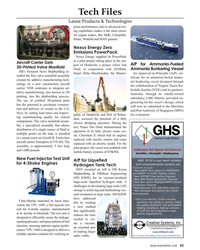 )
April 2025 - Maritime Reporter and Engineering News page: 43
)
April 2025 - Maritime Reporter and Engineering News page: 43by creating vation, the VPU 1600, a fuel injector test a new method unit for 4-stroke engines, manufactured that signi? cantly at its facility in Denmark. The test unit is reduces the time designed to ef? ciently assess the leakage, needed to cre- opening pressure, and spray pattern of fuel ate
-
 )
March 2025 - Marine News page: 27
)
March 2025 - Marine News page: 27back to 2007. He holds a Master of Science hydrogen for in Naval Architecture and Marine Engineering from Tech- now, because of nical University of Denmark and has completed manage- space constraints. ment and leadership programs at IMD Business School, Methanol, we have the Massachusetts Institute
-
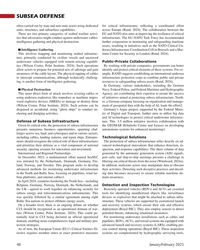 )
January 2025 - Marine Technology Reporter page: 40
)
January 2025 - Marine Technology Reporter page: 40, In December 2023, a multinational effort named SeaSEC port calls, and ship-to-ship meetings presents a challenge in was initiated by the Netherlands, Denmark, Germany, Fin- ? ltering out critical threats from the noise (Windward, 2024a). land, Norway, and Sweden. This program seeks to develop In addition
-
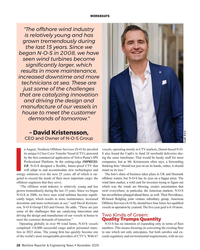 )
November 2024 - Maritime Reporter and Engineering News page: 28
)
November 2024 - Maritime Reporter and Engineering News page: 28new technologies and stand on its toes.” energy solutions over the next 25 years, all of which is tar- The lion’s share of business takes place in UK and Denmark geted to exceed the needs of their most important cargo: the offshore waters, but N-O-S has its eyes on a bigger prize. The offshore engineers
-
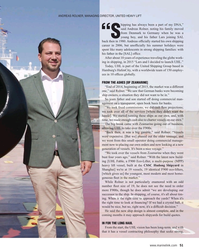 )
August 2024 - Maritime Reporter and Engineering News page: 51
)
August 2024 - Maritime Reporter and Engineering News page: 51ANDREAS ROLNER, MANAGING DIRECTOR, UNITED HEAVY LIFT hipping has always been a part of my DNA,” said Andreas Rolner, noting his family moved from Denmark to Germany when he was a “Syoung boy, and his father Lars joining SAL back then in 1980. Andreas of? cially started his own shipping career in
-
 )
August 2024 - Maritime Reporter and Engineering News page: 35
)
August 2024 - Maritime Reporter and Engineering News page: 35related to our engine business. The majority centivize investments to make the new technologies, the new are located in Europe, primarily in Germany and Denmark, fuels cost-competitive compared to fossil alternatives. Another important part is to accelerate the production of green synthetic and part of
-
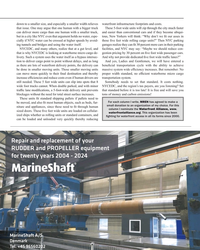 )
February 2024 - Maritime Reporter and Engineering News page: 11
)
February 2024 - Maritime Reporter and Engineering News page: 11very quickly thereby reducing Repair and replacement of your RUDDER and PROPELLER equipment for twenty years 2004 - 2024 MarineShaft A/S Denmark Tel. +45 96560202 marineshaft.com MR #2 (1-17).indd 11 2/6/2024 9:38:50 A
-
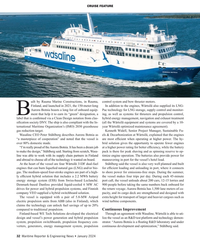 )
January 2024 - Maritime Reporter and Engineering News page: 32
)
January 2024 - Maritime Reporter and Engineering News page: 32per day. During each 45-minute energy storage system (ESS) from Swiss-based Leclanché. port call, the vessel unloads about 200 cars, 12-15 lorries and Denmark-based Danfoss provided liquid-cooled 6 MW AC 900 people before taking the same numbers back onboard for drives for power and hybrid propulsion systems
-
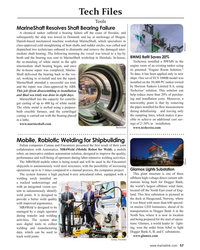 )
August 2023 - Maritime Reporter and Engineering News page: 57
)
August 2023 - Maritime Reporter and Engineering News page: 57Resolves Shaft Bearing Failure A chemical tanker suffered a bearing failure off the coast of Sweden, and subsequently the ship was towed to Denmark and lay at anchorage of Skagen. Danish-based mechanical machine workshop MarineShaft, which specializes in class-approved cold straightening of
-
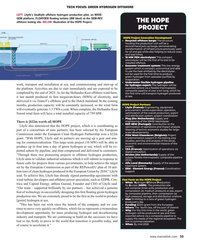 )
August 2023 - Maritime Reporter and Engineering News page: 55
)
August 2023 - Maritime Reporter and Engineering News page: 55, subsea ? exible thermoplastic composite pipeline Lhyfe aims to validate industrial solutions which it will submit in response to (TCP). • Alfa Laval (Denmark): Supply of the seawater future calls for projects from various governments, to help achieve the target treatment system. set by the European Commission
-
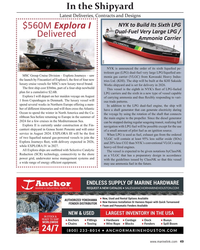 )
August 2023 - Maritime Reporter and Engineering News page: 49
)
August 2023 - Maritime Reporter and Engineering News page: 49of vessel capable Explora I will depart on her maiden voyage on August of carrying ammonia and thus ? exibly responding to vari- 1 from Copenhagen in Denmark. The luxury vessel will ous trade patterns. spend several weeks in Northern Europe offering a num- In addition to the LPG dual-fuel engine, the ship
-
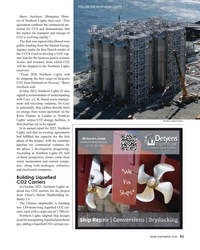 )
August 2023 - Maritime Reporter and Engineering News page: 43
)
August 2023 - Maritime Reporter and Engineering News page: 43, from which CO2 will be shipped to the Northern Lights reservoir. “From 2026 Northern Lights will be shipping the ? rst cargo of biogenic CO2 from Denmark to Norway,” Børre Jacobsen said. In May 2022, Northern Lights JV also signed a memorandum of understanding with Cory, a U.K. based waste manage- ment
-
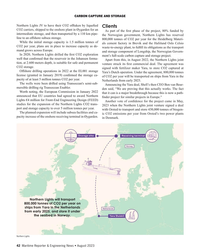 )
August 2023 - Maritime Reporter and Engineering News page: 42
)
August 2023 - Maritime Reporter and Engineering News page: 42subsea facilities and ca- ic CO2 emissions per year from Orsted’s two power plants pacity increase of the onshore receiving terminal in Øygarden. in Denmark. Northern Lights will transport 800,000 tonnes of CO2 per year on ships from Yara in the Netherlands from early 2025, and store it under the seabed
-
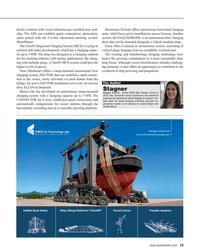 )
August 2023 - Maritime Reporter and Engineering News page: 19
)
August 2023 - Maritime Reporter and Engineering News page: 19to the vessel, easily activated via push button from the The Author bridge. An active NECTOR installation serves the all-electric ferry ELLEN in Denmark. Stagner Shore-Link has developed an autonomous ramp-mounted Maggie Stagner joined Elliott Bay Design Group in 2022. Her combined naval architecture
-
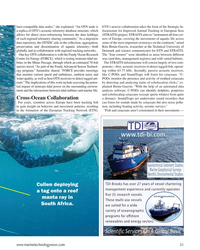 )
May 2023 - Marine Technology Reporter page: 31
)
May 2023 - Marine Technology Reporter page: 31of aquatic telemetry—both Kim Birnie-Gauvin, researcher at the Technical University of globally and in collaboration with regional tracking networks. Denmark and science communicator for ETN and STRAITS. One key OTN collaboration is with the Fundy Ocean Research The “four corners” were identi? ed as
-
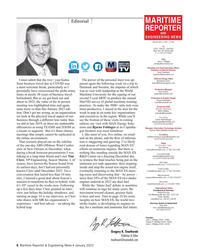 )
January 2023 - Maritime Reporter and Engineering News page: 6
)
January 2023 - Maritime Reporter and Engineering News page: 6[email protected] from business travel due to COVID was parent again the following week on a trip to a most welcome break, particularly as I Denmark and Sweden, the impetus of which Production Manager personally have crisscrossed the globe many was to visit with leadership at the World Irina
-
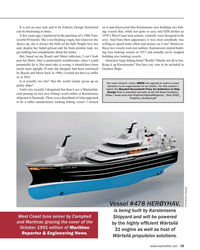 )
December 2022 - Maritime Reporter and Engineering News page: 19
)
December 2022 - Maritime Reporter and Engineering News page: 19the US Naval Academy. com posting on two new ? shing vessel orders at Karstensens https://www.usna.edu/EngineeringandWeapons/_files/2022_ shipyard in Denmark. There was a thumbnail of what appeared Program_Handout.pdf to be a rather anachronistic looking ? shing vessel. I clicked Vessel #478 HERØYHAV
-
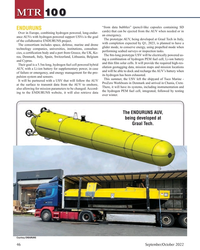 )
September 2022 - Marine Technology Reporter page: 46
)
September 2022 - Marine Technology Reporter page: 46or inspection tasks. cies, a certi? cation body and a port from Greece, the UK, Ko- The 8m-long prototype USV will be electrically powered us- rea, Denmark, Italy, Spain, Switzerland, Lithuania, Belgium ing a combination of hydrogen PEM fuel cell, Li-ion battery and Cyprus. and thin ? lm solar cells
-
 )
September 2022 - Marine Technology Reporter page: 22
)
September 2022 - Marine Technology Reporter page: 22grown from six employees in Newfoundland and Labrador to now having 214 employees globally with of? ces in Canada, US, Germany, Brazil, Scotland and Denmark. More than 140 of these employees are employed at its Canadian of? ces, located in Mount Pearl, NL, Dartmouth, NS and Toronto, ON. Kraken is one
-
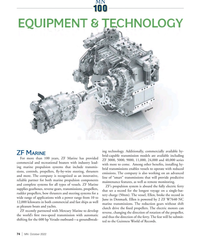 )
October 2022 - Marine News page: 74
)
October 2022 - Marine News page: 74and steering systems for a tery charge (50nm). The vessel, Ellen, broke the record in wide range of applications with a power range from 10 to June in Denmark. Ellen is powered by 2 ZF W7640 NC 12,000 kilowatts in both commercial and fast ships as well marine transmissions. The reduction gears without
-
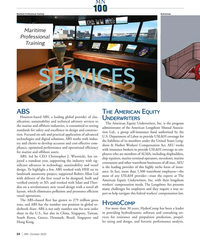 )
October 2022 - Marine News page: 54
)
October 2022 - Marine News page: 54one for new order share in the U.S., but also in China, Singapore, Taiwan, in providing hydrodynamic software and consulting ser- South Korea, Greece, Denmark, Brazil, Singapore and vices for resistance and propulsion prediction, propel- ler sizing and design, and forensic performance analysis. Hong Kong
-
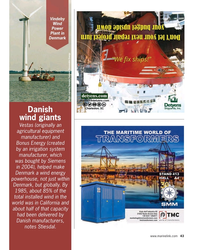 )
August 2022 - Maritime Reporter and Engineering News page: 43
)
August 2022 - Maritime Reporter and Engineering News page: 43Vindeby Wind Power Plant in Denmark Photo courtesy Siemens Gamesa Renewable Energy Danish wind giants Vestas (originally an agricultural equipment manufacturer) and Bonus Energy (created by an irrigation system manufacturer, which was bought by Siemens in 2004), helped make Denmark a wind
-
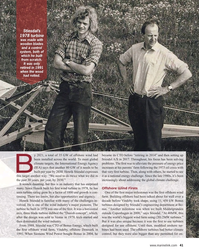 )
August 2022 - Maritime Reporter and Engineering News page: 41
)
August 2022 - Maritime Reporter and Engineering News page: 41was CTO of Bonus Energy, which built designed for use offshore. Until then, modi? ed onshore tur- the ? rst offshore wind farm, Vindeby, offshore Denmark in bines had been used. The offshore turbines had better climate 1991. When Siemens Wind Power bought Bonus in 2004, he control, but they were
-
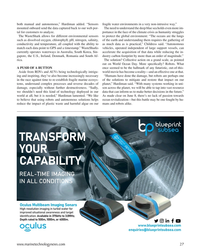 )
July 2022 - Marine Technology Reporter page: 27
)
July 2022 - Marine Technology Reporter page: 27currently operates waterways in Australia, South Korea, Sin- accelerate the acquisition of that data while reducing the in- gapore, the U.S., Ireland, Denmark, Romania and South Af- dustry carbon footprint by more than an order of magnitude.” rica. The solution? Collective action on a grand scale, as pointed
